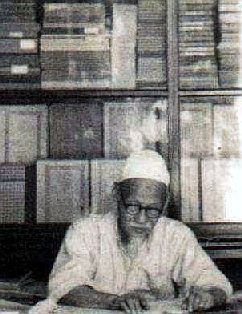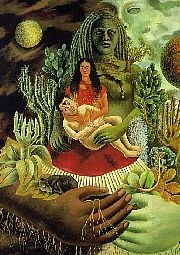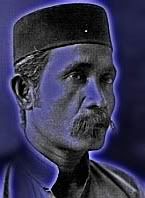Snapshots to the Past
Abdullah Dong (pronounced Tung) bin Sulaiman, came to Kuala Trengganu during the reign of Sultan Zainal Abidin III — al-Marhum Haji — in the early years of the twentieth century. (see, Hui Hui and Other People). In Kuala Trengganu he opened a shop that sold everything from shellac to rice to salt and books and Hari Raya cards. He was assisted in this venture by fellow emigrant Haji Hassan Liu bin Salleh, known widely as Pök Chang Siput.
Soon the shop trimmed its stock and specialised only in stationery, magazines and books. It became the sole agent in Trengganu for the Utusan Melayu and the Straits Times (later New Straits Times). In Trengganu, Abdullah Dong became known as Pök Löh Yunang, and the shop, Abdullah Al-Yunani, became Kedai Pök Löh Yunang, the famous purveyor of books and religious kitabs.
I am fortunate to have been sent this photo of Pök Löh in his shop by Encik Yahaya bin Mohd. Nor, his grandson. Encik Yahaya used to help in the shop in the days when he was still in shorts. He says that in the early days, some of the Hari Raya cards sold there were printed in the back of the shop.

Pök Löh in his bookshop
As a very young schoolboy I remember going there one Saturday morning to enquire about a book. It wasn't the very young Encik Yahaya I spoke to then, but a much older lad by the name of Shukor who told me that they no longer had the book in stock. "That was my elder brother who died last year," Encik Yahaya says.
Thanks to Encik Yahaya, I also now know that Pök Chang Siput had no connection at all with snails (siput), but was a masterchef known by his Chinese appellation of 'sifu' (master); so sifu became siput in Trengganuspeak.
Another man who arrived with Pök Löh, Ali Zhang bin Idris, became Pök Ali Yunang. Pök Ali was the man I described in my earlier blog as the alchemist. He had a shop in Jalan Kampung Daik where he sold roots and poultices and Chinese herbs, and also kept a stock of hardware goods, and sparklers for the end of Ramadhan. Pök Ali's ointment — Minyök Pök Ali — was much sought after for pains and aches.
Another bookseller from this remarkable group of Yunani pioneers in Kuala Trengganu was Abdullah's brother Pök Daud (Daud Dong) who specialised in religious books in his shop, also in Kedai Payang. Among his kitabs Pök Daud (Pök Ok) also kept an array of kris (made, probably, in Ladang), seeds, and brassware (most certainly from the brassworkers of Tanjong).
Encik Yahaya also very kindly sent me another interesting photo ("that I saved from my Mother's house, before the termites moved in") from the heyday of the Yunani brothers. This one was taken probably in the early 1940s, and shows a delegation of Chinese Muslims (mostly in white coat) being taken by Pök Löh to visit the Sultan Sulaiman Badrul Alam Shah at the Istana, though I'm uncertain which one. I'd hazard a guess and say that it was the Istana Kolam, though I haven't come across any records of fire damage to any of its out houses. (If you look closely in the background, you'll see, as Encik Yahaya points out, that the roof on the left has been gutted).

Chinese Muslim delegation with the Sultan.
Click HERE for bigger image.
In this picture, Sultan Sulaiman is seated in the centre. Standing 4th from left is Tengku Ismail, his brother, who later became Sultan Ismail Nasiruddin Shah. Pök Löh Yunang is seated second from left. I'd be grateful if anyone could shed further light on this photograph.
The Yunanis came to our part of the world via Indonesia and Singapore, then settled in Trengganu. From there they have spread even further: Pök Ali's grandson is now an Imam in a mosque in Sydney, Australia, and many are settled now in Kuala Lumpur and other parts of the peninsula.
Pök Löh died in Makkah circa 1954.
A young Yunani boy I used to know at school told me that they received cakes from relatives in Hong Kong during Chinese festivities. As it is now time for that, I wish my Chinese readers many happy cakes and a happy new year.
Gong Xi Fa Chai!


